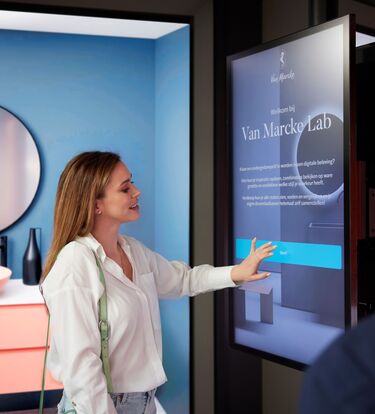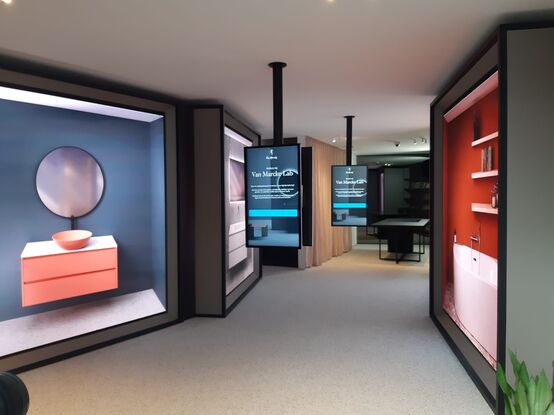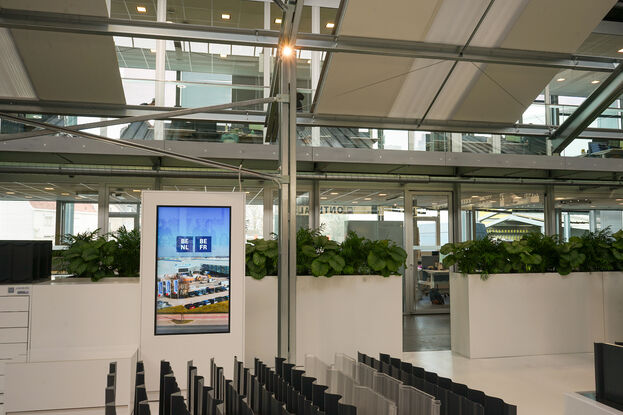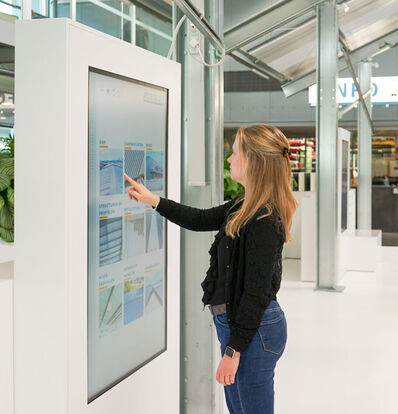Interview professor Breugelmans - "I consider digital applications mainly as an opportunity."

Els Breugelmans is a professor at KU Leuven. Her job includes both scientific research in the field of retail and lecturing (including Retailing & E-commerce) to students of Commercial Sciences. So the person par excellence to expose to some questions about experience in retail.
Could you tell us a bit more about your role as a professor in retail marketing?
'To be precise, I make analyses based on customer behaviour within a supermarket, e-commerce or other retail markets. My preferred personal approach is to carry out studies with behavioural data because this focuses on what customers do rather than what they say. We obtain this data mainly from loyalty card information or from market research agencies or companies that provide purchase data or (in the case of online shops) also search and click behaviour. In addition, I always look for a win-win situation: an academic study that answers a business-relevant question and at the same time provides added value in the science literature.'
What does the term experience imply for you?
'Experience to me is holistic, a lot of things can be covered by that term. In a recent academic study, we link experience to four sub-dimensions: customisation, fun, community and discovery. It's about discovering customised products, in a social and fun environment that inspires customers.'
1. Personalisation
‘Personalisation adds to the experience; a tailored experience has a big impact. One way to create a personalised experience is through technology in shop points that tell the bigger story and, in the best case, that technology reinforces the staff member in the whole story. After all, employees are part of that experience.’
‘The Van Marcke Lab is a great example of personalisation based on co-creation. You can provide personalisation by letting customers make their own choices (at a refill station, for example). In that case, the term personalisation is also used but at the Van Marcke Lab there is real collaboration. The employee solves a number of questions together with the customer to then put together a custom-made bathroom.’
2. Fun
‘The ‘fun’ element is all about shoppertainment: fun things that indirectly lead to a sale. Think, for example, of a sports shop with a climbing wall or a cinema in a furniture shop. This has nothing to do with the products as such, but it does create a lot of traffic and extra experience. Perhaps it is not the first approach but the Van Marcke Lab might also attract some curious customers in, who enjoy experiencing all that new technology.’
3. Community
‘In addition, the sense of belonging is also important, a community has to be built. People want to be part of something. This can be done actively by organising events and workshops in a retail outlet. For example, a retail chain with sports clothes can organise yoga sessions, such classes bring in customers and those customers then naturally see a lot of products.
Community can also run passively: by creating workstations in the shop, for example. You may then be sitting alone working, but the presence of others creates a sense of belonging somewhere.’
4. Discovery
‘A final dimension of experience is in providing inspiration. For example, gaining additional insight into a product before proceeding to a purchase. In a physical shop, all the senses can be fully exploited. This is also how discovery works in the Van Marcke Lab in Antwerp, with, for example, DeepScreen technology that shows bathrooms in an inspiring setting.’


Why is such an experience in a physical shop so important?
'A physical shop has a number of assets that are difficult to reproduce online. Certain senses like feeling and smelling are impossible to imitate in an online environment and that's where the physical shop makes the difference. So a shop that manages to leverage the four dimensions of experience has an advantage among customers.'
Will it remain that way in the future?
‘Tangibility and staff will remain key advantages for physical shops to stay relevant. However, I believe the online aspect should be more integrated into the physical space. Online shops enhance physical shops and vice versa. That way, in real life, you can also respond better to customer feelings and needs.’
'Note: every experience has its limits. If it becomes too extreme then the customer can no longer identify with it and that is obviously not the intention. Moreover, the convenience of shopping should not suffer. There should be a balance between the experience and the ease of shopping, both aspects have a significant impact on the shopping experience.'
In terms of experience in retail, is there room for improvement?
‘The retail sector in Belgium today is rather wait-and-see, there is still a lot of catching up to do. There are still many opportunities to better align the online environment and the physical shop. Too often retailers still forget that the online customer is the same as the one in the shop, they only think in terms of channels.
‘Take a showroom, for example: it may not always deliver something immediately in the form of transaction, but it can provide necessary inspiration to then possibly proceed to a purchase online. So this touchpoint is incredibly important in the customer journey, even if the actual conversion happens later. Being open to this and realising that an experience should not guarantee an immediate return in sales is important. It's about understanding that a shop is more than just a transaction place.’
‘In addition, don't forget that digital applications (smartphones) make sure that the competition is in the shop with you. Suppose the customer doesn't find the right product right away and gets frustrated. If there is no staff member right then to take care of this or a technological tool to retrieve information, there is a chance that the smartphone will be pulled out and a search for the item will be done online. And then, of course, the temptation is there for the price aspect in particular.’


How can anyone make an impactful digitalisation within the retail sector?
‘The biggest tip I can give is: reflect before you begin. Think carefully about which digital opportunities create added value. Which applications make sense and why? New trends do not necessarily have to be integrated into a retail shop immediately, beforehand think about whether they effectively contribute to better operations: are they adding value for the customer and/or the employee, then it becomes interesting to take further steps towards implementation.’
How does a retailer know what is valuable to the customer and what is not?
‘That requires a mindshift, a retailer has to think like the customer. Who is buying from me and what exactly are they looking for? Another interesting train of thought is to map the entire customer journey: where does a person drop out and why? What does the customer run into? Too many companies still think in terms of products and channels. This culture shift is already happening in the meantime, but there is still room for improvement.’
What challenges does ‘phygital’ (the mix of physical and digital) bring?
‘Phygital brings challenges in terms of data, among other things. It is difficult to map exactly which touchpoints lead to purchase because data is scattered everywhere... So there is an attribution challenge: what exactly leads to a purchase? Is it the showroom, is it the ads or does it come from the social media channels? A purchase may happen online, but all contact points leading up to it are also crucial. This is precisely why it is also important that content is aligned because if channels start communicating side by side, then we cannot talk about phygital. The customer expects one coherent story, one coherent look and feel.’
‘Another obstacle is privacy. If you want to provide tailor-made customer service, then you also need to be able to identify and track the customer. What actions does someone perform and how does it progress? To know this, you need access to data, and this for all touch points; something that is not so easy in a lot of organisations today and that can be aggregated.’
As a retailer, why is it wise to invest in a digital experience?
‘There can be several benefits associated with a digital experience in retail if customers also see the application as an added value. Customers then get a better experience because their needs are fulfilled better. The main goal is to help the customer better by providing the right info immediately, by simplifying the customer journey and by offering consistent info.’
‘Digital applications can also be good for employees, although they might sometimes be suspicious about digital applications. This is often because they were not involved in the preparation process. However, this is important because they will use the applications. The success of a digital application depends on employee enthusiasm. You should not see a digital solution as a replacement for the employee, but as a strengthening element. The team will operate the screens or provide additional explanations so they should be behind the choice.
Keep in mind that employees who have been in the company for a long time may need more time for that transition. People tend to stick to existing procedures. A new employee may be familiar with the digital solution in just a few days, as they may be less ‘stuck’ in the old practices. But that difference in pace may just trigger the experienced employee to do at least as well.’
‘Lastly, a digital experience also has benefits for the company itself. For example, certain routine jobs run much more efficiently thanks to technology, but there is still human contact.’


Digitale beleving in de showroom van Wienerberger Londerzeel.
How can you avoid that a digital experience is just a ‘gimmick’?
‘Beforehand, the purpose of the technology must be considered carefully. Just installing technology for the sake of installing technology is not a good idea, then we are actually talking about a gimmick. So my advice is: think beforehand about what you want to achieve. Do you mainly want to unburden your employees, do you want to create efficiency with your customers or is it mainly about stimulating engagement? Involve your employees and/or customers in this process to gain insight into this. That way, a digital application will be used for what it was designed for. The main goal, of course, is to help the customer and/or that employee as much as possible.’
How do you personally look at these digital solutions?
‘I see digital applications mainly as an opportunity. There are huge possibilities, but they need to be thought about in co-creation with the employees. Don't underestimate the power of the team. In addition, it is important to clearly define the purpose of the digital application. The digital experience must add value for both the customer and the employee.’
Thanks for the interview and the wise words!
Source: from the article ‘The future of physical shops: Create reasons for customers to visit'.
Fotocredits: © Van Marcke







